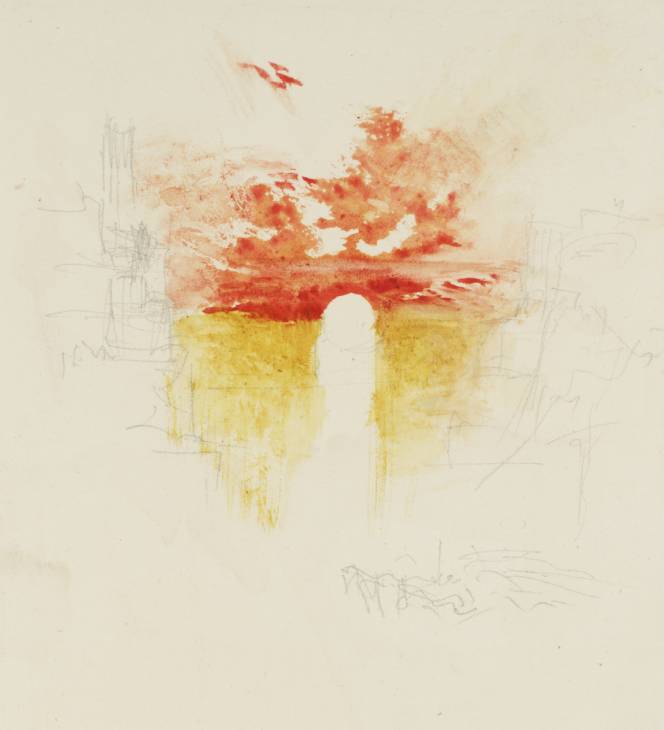Joseph Mallord William Turner Vignette Study for Moore's 'The Epicurean'; Sky for 'The Nile' c.1837-8
Joseph Mallord William Turner,
Vignette Study for Moore's 'The Epicurean'; Sky for 'The Nile'
c.1837-8
Joseph Mallord William Turner 1775–1851
Vignette Study for Moore’s ‘The Epicurean’; Sky for ‘The Nile’ circa 1837–8
D27599
Turner Bequest CCLXXX 82
Turner Bequest CCLXXX 82
Pencil and watercolour, approximately 125 x 130 mm on board, 226 x 178 mm
Inscribed by John Ruskin in red ink ‘(82’ bottom right
Stamped in black ‘CCLXXX 82’ bottom left, descending left-hand edge
Inscribed by John Ruskin in red ink ‘(82’ bottom right
Stamped in black ‘CCLXXX 82’ bottom left, descending left-hand edge
Accepted by the nation as part of the Turner Bequest 1856
Exhibition history
1974
Turner 1775–1851, Royal Academy, London, November 1974–March 1975 (297).
1976
J.M.W. Turner 1775–1851: Akvareller og Tegninger fra British Museum, Statens Museum for Kunst, Copenhagen, February–May 1976 (39, reproduced).
1976
William Turner und die Landschaft seiner Zeit, Hamburger Kunsthalle, May–July 1976 (58, reproduced).
1977
Turner Watercolors: An Exhibition of Works Loaned by The Trustees of the British Museum, International Exhibitions Foundation tour, Cleveland Museum of Art, September–November 1977, Detroit Institute of Arts, December 1977–February 1978, Philadelphia Museum of Art, March–April 1978 (55, reproduced in colour).
1989
Colour into Line: Turner and the Art of Engraving, Tate Gallery, London, October 1989–January 1990 (85, reproduced).
References
1909
A.J. Finberg, A Complete Inventory of the Drawings in the Turner Bequest, London 1909, vol.II, p.894, as ‘Sunset’.
1974
Martin Butlin, Andrew Wilton and John Gage, Turner 1775–1851, exhibition catalogue, Royal Academy, London 1974, p.101 no.2978 as ‘A Sunset – Study for a Vignette’.
1976
Werner Hofmann, Andrew Wilton, Siegmar Hosten and others, William Turner und die Landschaft seiner Zeit, exhibition catalogue, Hamburger Kunsthalle 1976, p.127 no.58, reproduced, as ‘Sonnenuntergang – Studie zu einer Vignette’ [A Sunset – Study for a Vignette].
1976
David Loshak and Andrew Wilton, J.M.W. Turner 1775–1851: Akvareller og Tegninger fra British Museum, exhibition catalogue, Statens Museum for Kunst, Copenhagen 1976, no.39, reproduced, as ‘A Sunset – Study for a Vignette’.
1977
Andrew Wilton, Turner Watercolors: An Exhibition of Works Loaned by The Trustees of the British Museum, exhibition catalogue, Cleveland Museum of Art 1977, pp.14, 74 no.55, reproduced, as ‘A Sunset: Study for a Vignette’.
1989
Anne Lyles and Diane Perkins, Colour into Line: Turner and the Art of Engraving, exhibition catalogue, Tate Gallery, London 1989, no.85, p.78 reproduced.
1993
Jan Piggott, Turner’s Vignettes, exhibition catalogue, Tate Gallery, London 1993, p.96, as ‘Sky for “The Nile” ’.
This dazzling study of a sun setting over water has been identified by Jan Piggott as a preliminary sketch for The Nile, circa 1838 (untraced),1 one of four vignette illustrations which Turner produced for John Macrone’s 1839 edition of Thomas Moore’s The Epicurean, a Tale: and Alciphron, a Poem. The finished watercolour was engraved by Edward Goodall and published to accompany Moore’s fantastical prose tale, The Epicurean.2
The study stands in stark contrast to Turner’s other sketches for Moore’s tale, which tend to be executed in pencil and pale pastel watercolour washes (for example, see Turner’s other study for The Nile, Tate D27630; Turner Bequest CCLXXX 113). The brilliant palette and bold composition of this study link it to another work in the Bequest, which is also thought to be a preparatory study for Moore’s tale (see Tate D27599; Turner Bequest CCLXXX 82).3 The similar execution of these two works suggests that they were almost certainly produced at around the same time and for the same project. Both studies were previously identified with Turner’s illustrations to Campbell’s Poetical Works, published by Moxon in 1837.4 However, the 1837 watermark on Pharos discounts this identification, since Turner finished his illustrations for Campbell’s Works no later than 1836.
The vibrant palette of both studies is particularly striking given that the illustrations were designed to be translated into monochrome engravings. Turner often deliberately employed bright colours in order to encourage his engravers to translate the spirit and effects of his compositions.5 His use of large areas of contrasting colour would have helped engravers to convert the tonal aspects of the composition into black and white.6
Andrew Wilton, The Life and Work of J.M.W. Turner, Fribourg 1979, p.456, no.1300; Piggott 1993, p.96.
W.G. Rawlinson, The Engraved Work of J.M.W. Turner, R.A., vol.II, London 1913, no.636. There is one impression in Tate’s collection (T06624); Thomas Moore, The Epicurean, a Tale: and Alciphron, a Poem, London 1839, reproduced between pp.152–3.
Technical notes:
Watermark ‘SE & Co. 1837’
Watermark ‘SE & Co. 1837’
Verso:
Inscribed by an unknown hand in pencil ‘CCLXXX 82’ bottom right
Meredith Gamer
August 2006
How to cite
Meredith Gamer, ‘Vignette Study for Moore’s ‘The Epicurean’; Sky for ‘The Nile’ c.1837–8 by Joseph Mallord William Turner’, catalogue entry, August 2006, in David Blayney Brown (ed.), J.M.W. Turner: Sketchbooks, Drawings and Watercolours, Tate Research Publication, December 2012, https://www

